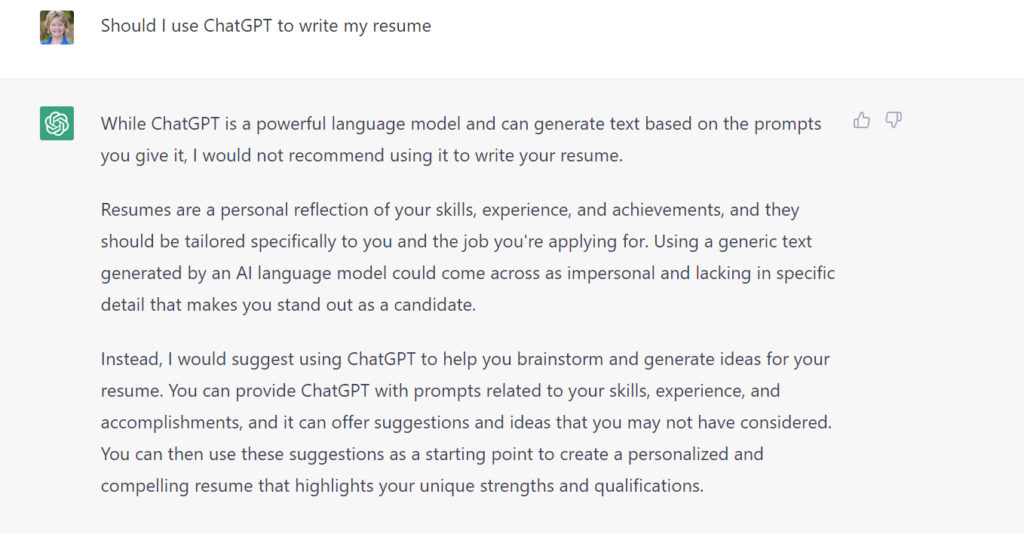
I recently sat down with Anne Janzer. She’s the author of several books on effective writing and has a special interest in how people write for and in the workplace.
Anne also coined the term servant authorship, a play on servant leadership.
Servant authorship is the discipline of getting to the heart of what the reader actually needs and delivering on that expectation.
Sounds simple, right? Unfortunately, we tend to overlook our audience’s interests as we hustle to get our content out.
The need for more focus on servant authorship couldn’t apply more to resume writers and job seekers.
You’ve heard me say it over and over…
When we write resumes, cover letters, and LinkedIn profiles, it’s so important to share experience that’s relevant to what the hiring team is looking for in a candidate.
Servant Authorship in an AI World?
A key tenet of servant authorship is authenticity (no surprise the words spring from the same root). Naturally, my conversation with Anne turned toward AI and ChatGPT. Specifically, how they apply to resume writing.
In case this is the first you’ve heard of it, ChatGPT is the latest tool from OpenAI, and it’s getting a lot of…well…chatter.
So I conducted my own test to see what all the buzz was about.
⚠️ Please note that ChatGPT is evolving as I write, as it continues to collect data from the web and feedback from users. So my analysis below reflects this point in time, and may easily be different next month. I’ll let you know.
For my experiment, I fed the bot a resume for a hypothetical candidate (a global technology executive) and a job description for a director of salesforce architecture role (although my findings can apply to any role).
I tested two types of cover letters (one where I fed the bot just the job description and one where I fed it both the job description and the resume), a new resume (using both the job description and original resume), and a LinkedIn About section (using the original resume).
I then broke down my thoughts into two buckets:
🚩 Red flags = Where I think ChatGPT failed the most
💡 Potential value = How I think ChatGPT could be useful
Read on for my hot take on whether ChatGPT is worth using for cover letters, resumes, and LinkedIn.
Prompt #1: Write a cover letter for director of salesforce architecture (the job description role)
🚩 Red flags:
- A few word-choice, grammatical, and punctuation errors.
- A sentence that used the exact wording from the job description—oops!
- Overused phrases, such as “seasoned architect.” As my colleague Marie Zimenoff likes to point out, there’s a place for seasonings—in the kitchen. 🧂
Note: The bot didn’t have any information on the candidate’s skills (because I wanted to isolate the job description’s required skills), so it was impossible to distinguish the candidate. This was the only prompt where I didn’t feed the bot the original resume.
💡 Potential value: The cover letter addressed most of the desired skills from the job description, so the content could serve as a guide for what keywords and experience matter most to the hiring manager.
Prompt #2: Write a cover letter based on the resume for a global technology executive
🚩 Red flags:
- More tired words and phrases, such as “results-oriented,” without actual achievements.
- Inability to tell a story that conveys that the candidate is unique. The bot included only one of the candidate’s achievements, even though it was fed several impressive data points.
- Confusion about the target job title. The letter included both the job description title AND the candidate’s existing title in the following sentence: “I am excited to apply for the position of Global Technology Leader [candidate’s title] at your organization and express my interest in the Director, Salesforce Architecture [job description title] role at….”
💡 Potential value: ChatGPT could be useful as a writing prompt, but you’ll need to then review the content carefully to catch mistakes and add details that matter to the reader.
Prompt #3: Write a resume for a global technology executive using elements from the global technology executive’s existing resume and the director of salesforce architecture job description
🚩 Red flags:
- Zero variation in font styles. The use of other basic styling tools was also nonexistent.
- No bullet alignment.
- “Summary” used as the resume headline. “Summary” is considered unnecessary and dated. A crisp candidate title, such as “Global Technology Leader,” is considered more modern.
- Generic paragraph below the headline, with vague statements that didn’t distinguish the candidate at all—even though the candidate won several awards and had multiple measurable achievements.
Pro tip: The top/branding section should be filled with achievements or skills the candidate offers, such as building award-winning global teams.
Take a look at my samples to get ideas for optimizing the headline and branding space.
🚩 Further resume red flags…
- Education above the Experience section. Someone at this level—and on a typical career progression—wouldn’t put their education above their experience.
- Skills listed below experience. Skills should be listed at the top, just below the summary/branding section.
- Pronouns. While not a deal breaker, the standard is to write resumes without pronouns. This keeps the content brief and avoids repetition of the word “I.”
- Outdated phrases such as “References available upon request.” Some of my colleagues reported that their test resume included an objective statement, which is really dated.
💡 Potential value: Honestly, I couldn’t find any value in using ChatGPT to write a resume, even as a starting point.
Of all the documents I asked the bot to write, the resume was the least impressive—and actually created more work in terms of cleanup than if I’d started writing from scratch.
See my previous suggestion to ask the bot for a cover letter—and then use that as a content guide to writing your resume.
Or, you could just go through your job descriptions and highlight the skills yourself.
Prompt #4: Write a LinkedIn About section based on the global technology executive’s resume
🚩 Red flags:
- Omission of some of the most impressive resume details.
- Repetition. Seven of nine sentences started with “I am…”🥱 Not to mention the servant authorship issue…
- Too many specific details, without demonstrating unique value. Like the cover letter, this is your opportunity to spotlight your brand, which is tough to do through a robot.
- Dense paragraphs. Limit lines to one or two sentences (max. three). People often read LinkedIn on their phones, and white space makes it easier.
💡 Potential value: The bot did write in the first person, which is preferred, but it was still dense and cold.
Again, this exercise works well as a writing prompt. Just be aware that you’ll need to correct grammatical errors, replace tired words and phrases, highlight your strengths, and remove inaccuracies.
⚖️ Verdict
Overall, I found that ChatGPT was missing:
- Personality and voice: Although I can select a voice (i.e. a famous author’s), ChatGPT doesn’t have enough content to write in my own voice…yet. I wonder if that would change if I continued to feed it original content.
- Modern formatting and original phrasing: There’s a definite lack of understanding of how resume standards have evolved over the past decade.
- Relevance: The bot didn’t pick up on what was most important for the role. Its choice of experience highlights from the hypothetical candidate’s resume seemed random. Reminder: What does the reader need to know?
- 100% accuracy: If you decide to test this yourself, be aware that ChatGPT will make mistakes and misrepresent some of your information.
Your special sauce is the main ingredient…
Some might argue that ChatGPT is impressive because it sounds just like any human. And there’s the rub. Who wants to sound like any human?
More specifically, do you want the reader to think you sound like every other applicant?
Bottom line: ChatGPT is a great tool as a writing prompt. But that’s all it is—a tool.
But don’t just take my word for it. Hear what ChatGPT has to say…

Don’t get me wrong. I’m grateful for AI that eases my workload. Siri’s a great example.
But although Siri’s a valuable assistant, I wouldn’t want to work with her all day.
If you’ve worked with me, you’ll recall that I ask you for your special sauce at the beginning of our intake meeting. That’s because I want to know what those special ingredients are that go into making you, you.
ChatGPT—at least for now—doesn’t have that deep-dive capability. Following the food analogy, Cade Metz, in a recent article the New York Times, put it well: “The systems write recipes with no regard for how the food will taste.”
The same can be said about ChatGPT’s ability to write a resume or other career documents.
As Anne Janzer might say, it doesn’t yet understand the rules of servant authorship.
But here’s the good news…
If your competitors are relying on bots to write their career documents, you have a great opportunity to stand out by putting in a little extra effort—and injecting the context, tone, personality, and originality that sets you apart.
Copyright © 2023 Words of Distinction, All rights reserved.
Image credit: baona from Getty Images Signature